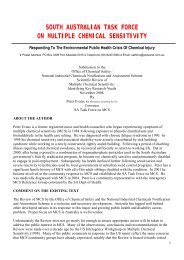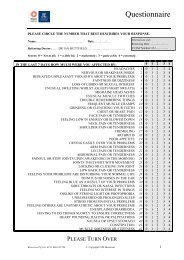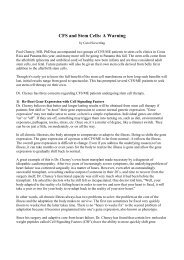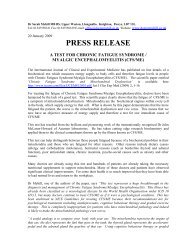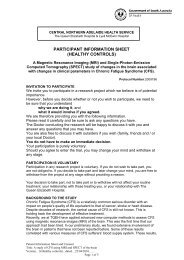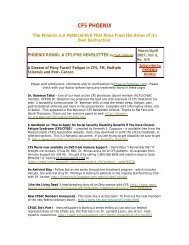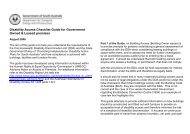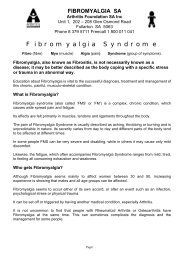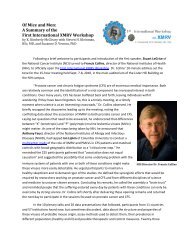16 G. Cassisi et al.The cardinal features are chronic widespread painin the presence of multiple tender points throughoutthe body on physical examination.FM, as defined by the American College ofRheumatology (ACR) 1990 definition for clinicaltrials, is a chronic widespread pain condition withcharacteristic tender points on physical examination,often associated with a constellation of symptomssuch as fatigue, sleep disturbance, headache,irritable bowel syndrome, and mood disorders. TheACR defined 2 major compulsory criteria for classifyingFM in adults. The first criterion is a historyof widespread pain for at least 3 months. Thesecond criterion requires patient report of tendernessin at least 11 of 18 defined tender points whendigitally palpated with about 4 kg per unit area offorce (3).Diagnosis is on the contrary made by a combinationof patient history, physical examination, laboratoryevaluations, and exclusion of other causesfor symptoms attributed to FM.It has also been noted that the ACR classificationcriteria focus only on pain and disregard other importantsymptoms of FM, including fatigue, cognitivedisturbance, sleep disturbance, and psychologicaldistress, and that focusing strictly on painmay fail to capture the “essence” of this syndrome(4). Three key features pain, fatigue and sleep disturbanceare present in virtually every patient withFM (5) even if the hallmark symptom that differentiatesFM from most other medical conditions isthe pronounced tenderness to even mildest palpationor physical touch, i.e. allodynia (6, 7).A recent study provided some evidence of the seriousnessof improper diagnosis, criticizing the disturbingdiagnostic error rate (66%) (8). With regardto this, the principal author of the 1990 ACR Criteriarecently published an editorial article entitled“Stop using the ACR Criteria in the Clinic” (9).In a very recent study, in order to develop a newdefinition of FM based on symptoms and withouttender points, the authors concluded that the keysymptoms are chronic widespread pain, nonrestorativesleep and subjective disabilities, implyingthat FM is more than just a pain disorder(10).In the late ’80s, Yunus proposed that preliminaryclinical criteria for FM should include some historicalfeatures besides the tender point count, adescription of pain as “hurt all over,” anxiety andstress, non restorative sleep, fatigue, irritable bowelsymptoms, and pain referred by patients in sevensites (11).Table I - Full O<strong>ME</strong>RACT 8 group responses in percentages (13).Domain A B CPain 94 3 3Fatigue 86 13 1Patient Global 81 12 7Sleep 64 26 10Multidimensional function 60 28 12HRQOL 52 34 14Tenderness 50 27 24Depression 44 34 21Treatment side effects 40 34 26Anxiety 22 43 35Dyscognition 21 42 37Stiffness 13 3552A: essential for core set for all clinical studie. B: necessary but not mandatory forIn 1992 a consensus document (the Copenhagendeclaration) identified FM is part of a wider syndromeinvolving headaches, bruxism, irritable bowel,irritable bladder, sleep disorders, dysmenorrhea,depression and anxiety disorders, cold sensitivity,Raynaud’s phenomena, restless legs, atypical patternsof numbness and tingling, complaints ofweakness, exercise intolerance, cognitive dysfunction,autonomic nervous system or neuroendocrinedysregulation (12).Temporomandibularpain anddysfunctionsyndromeRegionalfibromyalgia/MyofascialpainsyndromeRestlesslegssyndromePeriodic limbmovementdisorderFibromyalgiasyndromeCSSChronicfatiguesyndromePrimarydysmenorrheaIrritablebowelsyndromeMultiplechemicalsensitivityTensiontypeheadacheMigraineFigure 1 - Central Sensitivity Syndrome and its members with overlappingfeatures. From Yunus MB.Psychological aspects of fibromyalgiasyndrome: a component of the dysfunctional spectrumsyndrome. Baillieres Clin Rheumatol. 1994; 8(4): 811-37. In RachlinES, Rachlin IS. Myofascial Pain and Fibromyalgia, Trigger Point Management.2nd ed. St. Louis: Mosby, 2002 (adapted).
Symptoms and signs in fibromyalgia syndrome 17O<strong>ME</strong>RACT 8 workshop on FM in 2006, of whichthe principal objective was to work towards consensuson core domains for assessment in FM studies,identified key domains of pain, fatigue, sleepdisturbance, multidimensional function, quality oflife, mood disorders, and cognitive dysfunction.An additional domain highlighted by patients wasstiffness (13) (Table I). At last we cannot ignore theevolving idea of central sensitivity syndrome(CSS), which is based on neuroendocrine aberrationsinteracting with psychosocial factors. CSSbecomes an important new concept that embracesthe biopsychosocial model of disease as a usefulparadigm and an appropriate terminology for FMand related conditions (14, 15) (Fig. 1).THE SYMPTOMSThe most common and characteristic symptoms ofFM are generalized pain, stiffness, fatigue, andpoor sleep. Other symptoms are a swollen feelingin soft tissue and paresthesia. Several associated illnesses,more common in FM patients than in normalpopulation (as well as in those with otherchronic pain conditions) have been well described(16).MUSCULOSKELETAL SYMPTOMSPainAs mentioned, the defining symptom of FM remainswidespread chronic pain that lasts at leastthree months, usually present in all four limbs, aswell as the upper or lower back. About two thirdsof the patients state that they “hurt all over”; thissymptom has been found to be useful in differentiatingFM from other conditions (11).Pain may be described as any combination of burning,searing, tingling, shooting, stabbing, deepaching, sharp and feeling bruised all over (17).Some authors, using an adapted McGill Pain Questionnaire,found that pain in FM had a greater spatialdistribution and involved a greater number ofpain descriptors compared to other pain syndromes(18).Common sites of pain are low back, neck, shoulderregion, arms, hands, knees, hips, thighs, legs,feet (19), and anterior chest (20). However, pain isusually generalized and in “non-anatomical” distributionor regional; it does not follow any definitestructural or nerve root distributions, it is perceivedas originating in the muscle or deep in bones (17),although in a subgroup of patients it is predominantlyarticular (21).Characteristics of FM pain include allodynia, hyperalgesia,persistent pain, summation effects, hyperpatiain the skin and tenderness on examination.Pain is often aggravated, like stiffness, by cold orhumid weather, anxiety or stress, overuse or inactivity,poor sleep (19, 22) and noise (20). The worsttimes for an FM patient are in the morning, the latterhalf of the afternoon, and evening (23).Myalgia and muscle dysfunctionsPain often includes widespread myalgia that is notnecessarily confined to the tender points, and withcharacteristics that vary widely even in an individualpatient. It can also appear as low back pain,sometimes simulating sciatica; in this case theremay be a concomitant myofascial pain syndrome(piriformis, gluteus).Approximately 40% of FM patients reported legcramps in comparison to 2% of controls (24).Myalgia can be accompanied by muscle weaknessand fasciculations with or without general weakness.Muscle function is globally impaired (most ofall aerobic processes) (25) and strength is generallyreduced in the hand and quadriceps, in particular(26).Many studies failed to demonstrate typical and specificmuscle abnormalities. Bioptic studies (27-29)revealed only non-specific signs of muscle pathologywithout pathognomonic flags of FM. Needleelectromyography found minor and, again, nonspecificchanges looking for pathological evidenceof motor unit recruitment (no loss of motor unitsand no fiber degeneration) (30). Multichannel surfaceelectromyography seems to be of some interest,giving original information about acute alterationof motor unit recruitment strategies andchronic modification of muscle fiber type distribution,number or size (31, 32). Muscle alterationthat is clinically expressed as fatigue could be theperipheral aspect of a central alteration of the sensory-motorinteraction.Muscles in a patient with FM probably undergo apathologic remodelling related to an alteredsuprasegmental control (33). Because of this, theirfunction is incorrect and ineffective.However, these results are not strictly related to fibromyalgicmuscle; they have also been recorded,for example, in healthy, deconditioned elderly populations(34).
- Page 2 and 3: 2 P. Sarzi-Puttini et al.The meetin
- Page 4 and 5: 4 M. Cazzola et al.(2). In the earl
- Page 6 and 7: 6 M. Cazzola et al.enough to meet F
- Page 8 and 9: 8 M. Cazzola et al.Table I - Charac
- Page 10 and 11: 10 M. Cazzola et al.Table IV - Cond
- Page 12 and 13: 12 M. Cazzola et al.teria, three su
- Page 14 and 15: 14 M. Cazzola et al.tients with a n
- Page 18 and 19: 18 G. Cassisi et al.StiffnessIn FM
- Page 20 and 21: 20 G. Cassisi et al.Autonomic and n
- Page 22 and 23: 22 G. Cassisi et al.Associated symp
- Page 24 and 25: 24 G. Cassisi et al.46. Coleman RM,
- Page 26 and 27: 26 S. Stisi et al.sensitization,”
- Page 28 and 29: 28 S. Stisi et al.Sum oflife-events
- Page 30 and 31: 30 S. Stisi et al.trols, they prese
- Page 32 and 33: 32 S. Stisi et al.stress, obtained,
- Page 34 and 35: 34 S. Stisi et al.50. Harris RE, Cl
- Page 36 and 37: ORIGINAL ARTICLEReumatismo, 2008; 6
- Page 38 and 39: 38 F. Atzeni et al.lalanine (17), a
- Page 40 and 41: 40 F. Atzeni et al.clearer and it m
- Page 42 and 43: 42 F. Atzeni et al.healthy control
- Page 44 and 45: 44 F. Atzeni et al.and/or verbal (e
- Page 46 and 47: 46 F. Atzeni et al.for study purpos
- Page 48 and 49: 48 F. Atzeni et al.mimics of fibrom
- Page 50 and 51: ORIGINAL ARTICLEReumatismo, 2008; 6
- Page 52 and 53: 52 P. Sarzi-Puttini et al.A larger
- Page 54 and 55: 54 P. Sarzi-Puttini et al.from 1966
- Page 56 and 57: 56 P. Sarzi-Puttini et al.rational,
- Page 58 and 59: 58 P. Sarzi-Puttini et al.49. Toffe
- Page 60 and 61: 60 R. Casale et al.cal exercise and
- Page 62 and 63: 62 R. Casale et al.definition of
- Page 64 and 65: 64 R. Casale et al.are more or less
- Page 66 and 67:
66 R. Casale et al.trol associated
- Page 68 and 69:
68 R. Casale et al.32. Lewit K. The
- Page 70 and 71:
ORIGINAL ARTICLEReumatismo, 2008; 6
- Page 72 and 73:
72 L. Altomonte et al.In a clinical
- Page 74 and 75:
74 L. Altomonte et al.Table II - We
- Page 76 and 77:
76 L. Altomonte et al.treatments de



